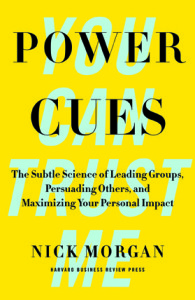 You get two ideas for the price of one in this blog post: how to get an annoying song out of your head and how to get in the right frame of mind for that high-stakes meeting or presentation. The technique is the same for both.
You get two ideas for the price of one in this blog post: how to get an annoying song out of your head and how to get in the right frame of mind for that high-stakes meeting or presentation. The technique is the same for both.
We all occasionally get a tune stuck in our minds, one that plays endlessly and annoyingly despite our best efforts to try to get rid of it. In fact, the more we fight it, the deeper it gets entrenched. I’ve found a simple way to solve the problem: substitution.
You can’t fight the loop going through your head, because paying it attention just feeds it. So, what I do is choose a different tune and play that in my head for a minute or two. You can’t play two tunes at once, so the new tune pushes out the old bothersome one. Many times, one substitution is all you need, and the new tune quickly fades out – but the old one is gone.
Of course, you run the danger of having the new tune take root and become just as irritating, so if it persists more than a minute or two, just pick a different tune and try again. The trick is not to let the new one stick in your mind for very long.
So what does this have to do with getting in the right frame of mind for a presentation? If you get nervous before a presentation, it’s hard to get that feeling out of your mind, and telling yourself that you’re confident only makes you more anxious.
But just like your brain can only play one tune at a time, you can only feel one emotion at a time. So the same trick applies: substitute a powerful or confident emotion for the anxious one. This is a little harder, but still easily within your power to do. Get your mind into the right emotional state by recalling a time when you felt strong and confident, or when you were excited to deliver good news to someone. Excitement is especially powerful because the physical feeling is almost identical to what you feel when you’re nervous.
Actors know it as the “offstage beat”, according to Nick Morgan in his book, Power Cues. They evoke the necessary emotion for the scene before going on stage, so when the time comes, they are not “acting” – the emotion they show is genuine. They’re not thinking about the audience’s reactions, or that they may be nervous, because they only have room for one emotion at a time.
Just like the song in your head, if you can’t turn it off, at least you can change the station!
 Nick Morgan has written two very good books on presentations and persuasive communications[1], so I looked forward to reading his new book, Power Cues: The Subtle Science of Leading Groups, Persuading Others, and Maximizing Your Personal Impact
Nick Morgan has written two very good books on presentations and persuasive communications[1], so I looked forward to reading his new book, Power Cues: The Subtle Science of Leading Groups, Persuading Others, and Maximizing Your Personal Impact. For the most part, I was not disappointed. The book contains a lot of solid material which can definitely help anyone who wants to strengthen their skills and boost their personal influence.
Everyone can get something different out of this book, depending on their baseline level of knowledge of nonverbal communication. Without false modesty, I can say that I have read dozens of books and hundreds of articles on the topic, including almost all of his principal sources. But I also learned a lot, because Morgan supplements the research by incorporating it into his own system based on his long experience. It’s obvious that he knows what he’s talking about and what he’s doing.
The theme of the book is that your unconscious mind is hugely influential in your perceptions and decisions, and you can become a better communicator by gaining control over your own cues and becoming more skilled at reading others.
There are seven power cues, each covered in its own chapter. I personally found the first two the most useful: becoming self-aware of how you present yourself to others and then taking charge of your nonverbal communication. One excellent point is that “charisma is focused emotion”, but because it’s almost impossible to focus on your material and your own body language at the same time, you need to put yourself into the right state of mind before that important meeting or big presentation, and the book describes techniques that method actors use before they go on stage.
The third chapter concerns reading the signals of others. Morgan pays lip service to Paul Ekman’s work on micro-expressions, but then sensibly tells us that it’s too complicated to use in normal situations. Morgan’s key insight is that we are already experts in reading nonverbal cues, but we don’t always know how to tap into that knowledge. His approach is to teach you how to listen to your unconscious mind by asking yourself four fundamental questions: Is this person: friend or foe? Telling the truth? On my side? Powerful or not?
After the first three chapters, the book became less useful to me, but that may just be a personal reaction. Chapter four concerns the proper use of your voice. It’s no great revelation that deeper voices are perceived as more powerful, but there is not too much that you can do about it. You can work on your breathing, or you can use a piano to find your “maximum resonance point” (and I have to admit I got totally lost on that one).
Chapter 5 goes deeper into the combination of body language and voice, using the framework from the book, Honest Signals, by Sandy Pentland. I find some of the suggestions a bit gimmicky, especially the idea of trying to manipulate others by mirroring their movements, but there are some good ideas in here.
Chapter 6 made me scratch my head a bit, trying to figure out how it fits in with the rest of the book. It’s about using self-affirmation to harness the power of your unconscious mind.
Chapter 7 is about using stories to really connect with your audiences. This chapter is very practical, with excellent suggestions on how to structure and tell stories. It’s a nice strong finish to the book.
Will this book make you a better communicator? Maybe – it depends on you. I have two caveats. The first is one that Morgan himself issues in the book: these are subtle and difficult skills that require practice to master. You can’t become an instant expert just by reading about a new technique, any more than you can shoot a basketball better because you watched Lebron James on TV last night. Second, you always have to keep in mind that cues don’t trump content in the long run. In fact, if you have strong content backed by solid evidence, you will probably radiate these cues naturally.
Despite my reservations, I still give the book five stars because I believe that regardless of where you start from, there are plenty of practical ideas in this book to make you a more persuasive communicator. Read it, choose the ideas that you think will work for you, and then practice, practice, practice!
[1] Give Your Speech, Change the World: How to Move Your Audience to Action, and Trust Me: Four Steps to Authenticity and Charisma


